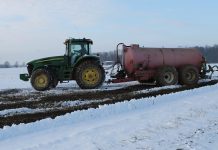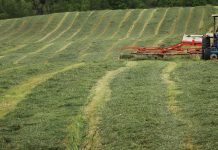Three years ago come July 1, 70 percent or so of American dairy farmers began taxing themselves to fund a program the industry dubbed Cooperatives Working Together, or CWT.
The tax was puny, a nickel per hundredweight, or 5 cents for each 11.6 gallons, of milk farmers sold through their cooperatives.
CWT (a take-off on the abbreviation for hundredweight, cwt., the unit by which American milk is sold) was the brainchild of the National Milk Producers Federation, the Washington, D.C. lobby of the nation’s dairy cooperatives.
Simple goal. National Milk Producers made CWT’s goal simple: the money would fund a multi-pronged, voluntary, self-help program to boost farm milk prices.
To do so, CWT would create pools in which dairy farmers could “bid” their cattle into the slaughterhouse. If CWT accepted the dairymen bids, entire herds would be slaughtered to cut future milk production and farmers would keep slaughter receipts and get an additional check from CWT.
CWT’s would also operate an export assistance program. The export subsidy would cover the gap between higher domestic prices and cheaper world prices to underwrite more American exports.
Unlikely. Given the size of the U.S. dairy industry, this outside-the-government plan was as ambitious as it was audacious.
To impact prices, CWT would have to kill tons of cows and move tons of exports in the then-170 billion pounds of milk per year U.S. dairy industry.
But producers – or at least their cooperative bosses – believed.
From July 1, 2003 to May 31, 2006, CWT spent $180 million of volunteered funds to slaughter 147,252 dairy cows that, CWT calculates, removed 2.84 billion pounds of potential milk from the market.
Additionally, dozens of export buy-downs moved thousands of tons of cheese, butter, powdered milk and other products overseas.
Closer inspection. Good, right? CWT thought so.
In a Jan. 20, 2004, press release, it reported that its first six-month effort lifted domestic producer prices by 60 cents per hundredweight and resulted “in $1.014 billion in additional dairy farm income.”
That impact, however, is surely overstated because it’s virtually impossible to isolate the effect of removing 1.2 billion pounds, or 0.7 percent, of milk out of the 170.3 billion pounds produced in 2003.
Additionally, 2004 was gearing up to be the best milk price year ever. Led by a 4 percent surge in demand and only a 1 percent increase in production, milk prices averaged a record $16 per hundredweight.
Yet, the perceived 2003 success led CWT to continue to fund whole herd buy-outs and export price buy-downs throughout 2004 and 2005 even as record to near-record milk prices drove up both programs’ costs.
(Farmers need bigger bucks to kill their mini-milk factories when the factories are spurting pure gold.)
Walking blindly. The programs, blinded by the perceived success, moved on until, on May 31 this year, they posted a $19.4 million deficit.
It simple terms, CWT burned through its cash wad, then turned to its credit card.
As such, on July 1, CWT will double the voluntary contribution to a dime per hundredweight to cover the debt and raise another $180 million to continue the programs for another 18 months.
CWT anticipates some producers begging out but “most will move to the dime.”
Should they? Probably not.
Doubtful impact. While the programs have killed cows and moved product overseas, their impact on market prices is extremely doubtful.
When CWT began in 2003, the USDA estimated the U.S. had 9.08 million dairy cows producing 170.3 billion pounds of milk.
For 2006, USDA estimates the U.S. dairy herd at 9.1 million head and milk production at 181.3 billion pounds.
In short, despite CWT efforts, the U.S. now has 20,000 more cows making 11 billion pounds more milk.
CWT is not just swimming against the current, it’s drowning in it. Looked at from another angle, the herd buy-out and export buy-down are similar to raking leaves in a hardwood forest in October.
Are you raking leaves? Certainly. Will you be able to see that you’ve raked leaves tomorrow? Certainly not.
Dairy farmers should tell their cooperatives that CWT isn’t self-help; it’s self-delusion. And at $360 million, it ain’t cheap.
(Alan Guebert’s Farm and Food File is published weekly in more than 75 newspapers in North America. He can be contacted at agcomm@sbcglobal.net
.)













